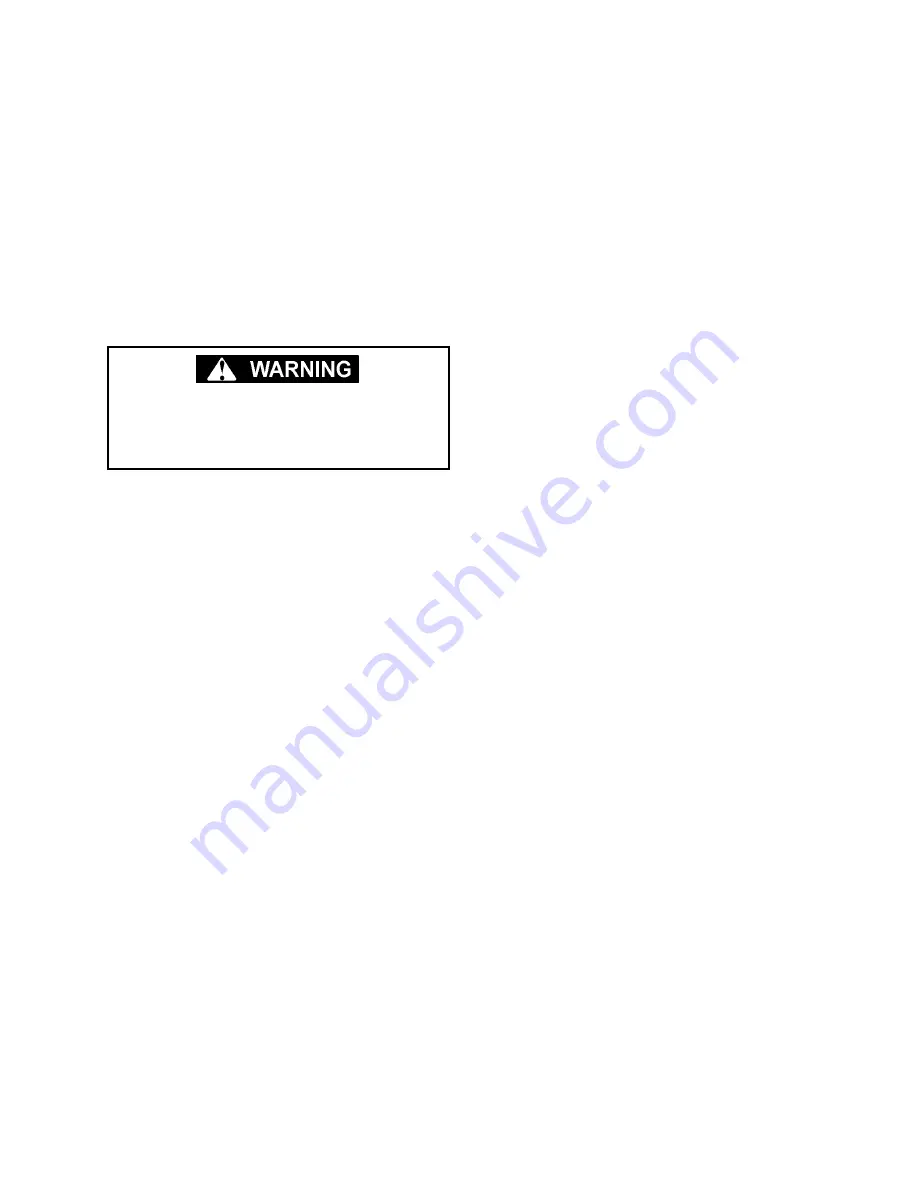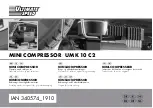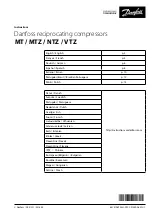
Section 2
DESCRIPTION
9
tion while supplying air to the system. This valve
also acts as a check valve preventing compressed
air in the service line from bleeding back into the
receiver on shutdown and during operation on the
compressor in an unloaded condition.
A pressure relief valve (located on the wet side of
the separator) is set to open at rated tank pressure.
The compressor is also equipped with high pres-
sure shutdown protection to shut down at high MAX
P1 setpoint. This prevents the relief valve from
opening. High temperature probes are provided to
shut down the compressor.
Fluid is added to the sump via a capped fluid filler
opening, located on the tank to prevent overfilling of
the sump. A sight glass enables the operator to
visually monitor the sump fluid level.
2.6 CAPACITY CONTROL SYSTEM, FUNCTIONAL
DESCRIPTION
Refer to Figures
as well as Sections
List portion of this manual. The purpose of the
compressor control system is to regulate the com-
pressor air intake to match the amount of com-
pressed air being utilized. At 0 to 10 percent air
output, the control system will automatically unload
the compressor and reduce power consumption.
The unload sump pressure can be set using the
unload control regulator valve (140-175 psig).
The
Control System
consists of an
inlet poppet
valve
,
startup solenoid valve
,
reference (equal-
izing) pressure regulator
,
blowdown solenoid
valve
,
pneumatic blowdown valve
,
control pres-
sure regulator
,
unload pressure regulator
,
sequencing solenoid valve
, and a
control line
filter
located prior to the controls.
The functional description of the Control System is
described below in five distinct phases of the com-
pressor operation. For explanation purposes, this
description will apply to compressors with an oper-
ating range of 350 to 360 psig (24.1 to 24.8 bar). A
compressor with any other pressure range would
operate in a similar manner except for the stated
pressures.
START MODE - TO 160 PSIG (11 BAR)
When the compressor start button is depressed,
the pressure will rise from 0 to 160 psig (0 to 11
bar). During this period, the control inlet solenoid is
closed, which keeps the inlet poppet valve closed.
The control pressure regulator is also closed at this
time. After the startup timer times out, the startup
solenoid valve changes state and the reference
pressure regulator controls the pressure signal to
the poppet valve at a maximum 60 psig (4 bar).
The inlet poppet valve opens allowing full airflow to
the compressor inlet and the discharge pressure
builds to approximately 160 psig (11 bar). No air is
supplied to the system service line during this
phase by the minimum pressure valve. When the
discharge pressure exceeds approximately 160
psig (11 bar), the minimum pressure valve may
start to open and allow air to flow to the system
service line.
NORMAL OPERATION MODE - 160 TO 350 PSIG
(11 TO 24.1 BAR)
When the sump pressure rises above 160 psig (11
bar), the minimum pressure valve opens and deliv-
ers compressed air to the system service line.
From this point on, a line air pressure transducer
continually monitors the air pressure. The control
pressure regulator valve remains closed during this
phase, keeping the inlet poppet valve wide open.
The blowdown solenoid valve also remains closed
during this phase. Flow will occur when the dis-
charge pressure is higher than the line pressure.
The check valve, which is built into the minimum
pressure valve, will prevent back flow into the com-
pressor.
MODULATING MODE - 350 TO 360 PSIG (24.1
TO 24.8 BAR)
If less than the rated capacity of compressed air is
being used, the system service line pressure will
rise above 350 psig (24.1 bar). The control pres-
sure regulator valve gradually opens applying air
pressure to the control side of the inlet poppet
valve, which modulates the position of the inlet pop-
pet valve. This reduces the amount of air entering
the compressor until it matches the amount of air
being utilized. The control system functions contin-
ually in this manner, between the limits of 350 to
360 psig (24.1 to 24.8 bar) in response to varying
demands from system service line. The control
pressure regulator valve has an orifice, which vents
a small amount of air to the atmosphere when the
control pressure regulator valve modulates the inlet
poppet valve.
DO NOT remove caps, plugs, and/or other com-
ponents when compressor is running or pressur-
ized.
Stop compressor and relieve all internal pressure
before doing so.
Summary of Contents for LS20T 1100 CFM
Page 18: ...Section 2 DESCRIPTION 12 Figure 2 3B Control System Diagram START...
Page 19: ...Section 2 DESCRIPTION 13 Figure 2 3C Control System Diagram MODULATION...
Page 20: ...Section 2 DESCRIPTION 14 Figure 2 3D Control System Diagram FULL LOAD...
Page 21: ...Section 2 DESCRIPTION 15 Figure 2 3E Control System Diagram UNLOAD...
Page 44: ...NOTES 38...
Page 104: ...Section 9 ILLUSTRATIONS AND PARTS LIST 98 02250146 367R00 9 19 CONTROL START SYSTEM...
Page 106: ...Section 9 ILLUSTRATIONS AND PARTS LIST 100 02250146 367R00 9 19 CONTROL START SYSTEM...
Page 108: ...Section 9 ILLUSTRATIONS AND PARTS LIST 102 02250138 633R00 9 20 CONTROL PANEL...
Page 110: ...Section 9 ILLUSTRATIONS AND PARTS LIST 104 02250139 119R01 9 21 ENCLOSURE...
Page 112: ...Section 9 ILLUSTRATIONS AND PARTS LIST 106 02250139 119R01 9 21 ENCLOSURE...
Page 114: ...Section 9 ILLUSTRATIONS AND PARTS LIST 108 9 22 DECAL GROUP...
Page 116: ...Section 9 ILLUSTRATIONS AND PARTS LIST 110 9 22 DECAL GROUP...
Page 118: ...Section 9 ILLUSTRATIONS AND PARTS LIST 112 9 22 DECAL GROUP...
Page 120: ...Section 9 ILLUSTRATIONS AND PARTS LIST 114 9 23 DECAL LOCATIONS OPEN AIR COOLED...
Page 122: ...Section 9 ILLUSTRATIONS AND PARTS LIST 116 9 24 DECAL LOCATIONS OPEN WATER COOLED...
Page 124: ...Section 9 ILLUSTRATIONS AND PARTS LIST 118 9 25 DECAL LOCATIONS REMOTE COOLER...
Page 126: ...Section 9 ILLUSTRATIONS AND PARTS LIST 120 9 26 DECAL LOCATIONS CONTROL BOX...
Page 128: ...Section 9 ILLUSTRATIONS AND PARTS LIST 122 9 27 ENCLOSURE DECALS...
Page 145: ...NOTES 139...
















































